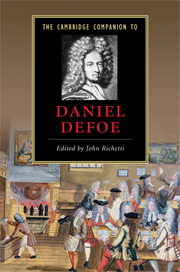Book contents
- Frontmatter
- Introduction
- 1 Defoe: the man in the works
- 2 Defoe’s political and religious journalism
- 3 Defoe, commerce, and empire
- 4 Defoe and criminal fiction
- 5 Money and character in Defoe’s fiction
- 6 Defoe’s Tour and the identity of Britain
- 7 Defoe as narrative innovator
- 8 Gender and fiction in Moll Flanders and Roxana
- 9 Defoe and London
- 10 Robinson Crusoe: varieties of fictional experience
- 11 Defoe: satirist and moralist
- 12 Defoe and poetic tradition
- Further Reading
- Index
4 - Defoe and criminal fiction
Published online by Cambridge University Press: 28 March 2009
- Frontmatter
- Introduction
- 1 Defoe: the man in the works
- 2 Defoe’s political and religious journalism
- 3 Defoe, commerce, and empire
- 4 Defoe and criminal fiction
- 5 Money and character in Defoe’s fiction
- 6 Defoe’s Tour and the identity of Britain
- 7 Defoe as narrative innovator
- 8 Gender and fiction in Moll Flanders and Roxana
- 9 Defoe and London
- 10 Robinson Crusoe: varieties of fictional experience
- 11 Defoe: satirist and moralist
- 12 Defoe and poetic tradition
- Further Reading
- Index
Summary
On the morning of his death, the celebrated housebreaker and prison escape artist John Sheppard bequeathed his life story to the press. According to one source, at the scene of his impending execution Sheppard “sent for Mr. Applebee, a printer, into the Cart, and, in view of several thousands of People, delivered to him a Pamphlet, entitled, A Narrative of all his Robberies and Escapes.” Then, according to a later account, Sheppard “said in a loud clear voice that this was his authentic confession and that he wished Mr. Applebee to print it for him. It was an effective advertisement. That night thousands of copies of the pamphlet were sold for a shilling in the streets.” The pamphlet in question, A Narrative of all the Robberies, Escapes, & of John Sheppard, was attributed to Daniel Defoe by the Victorian Defoe connoisseur William Lee in 1869, and in fact Lee added an interesting twist to the tale: the man to whom Sheppard handed his manuscript was not Applebee at all but an imposter - none other than Defoe himself. Lee devised an elaborate story of deceit to place Defoe at the scene of Sheppard's death. He held that Defoe, impersonating Applebee (with Applebee's consent), had visited Sheppard in prison to obtain his life story firsthand, and that Sheppard had thus been tricked into telling that story to an author he imagined, if there's any truth to Lee's hypothesis, to be somebody else. As Applebee was the leading publisher of criminal lives in the period, perhaps Defoe meant to flatter Sheppard's vanity by pretending that the great man himself took a personal interest in his case.
- Type
- Chapter
- Information
- The Cambridge Companion to Daniel Defoe , pp. 64 - 83Publisher: Cambridge University PressPrint publication year: 2009

